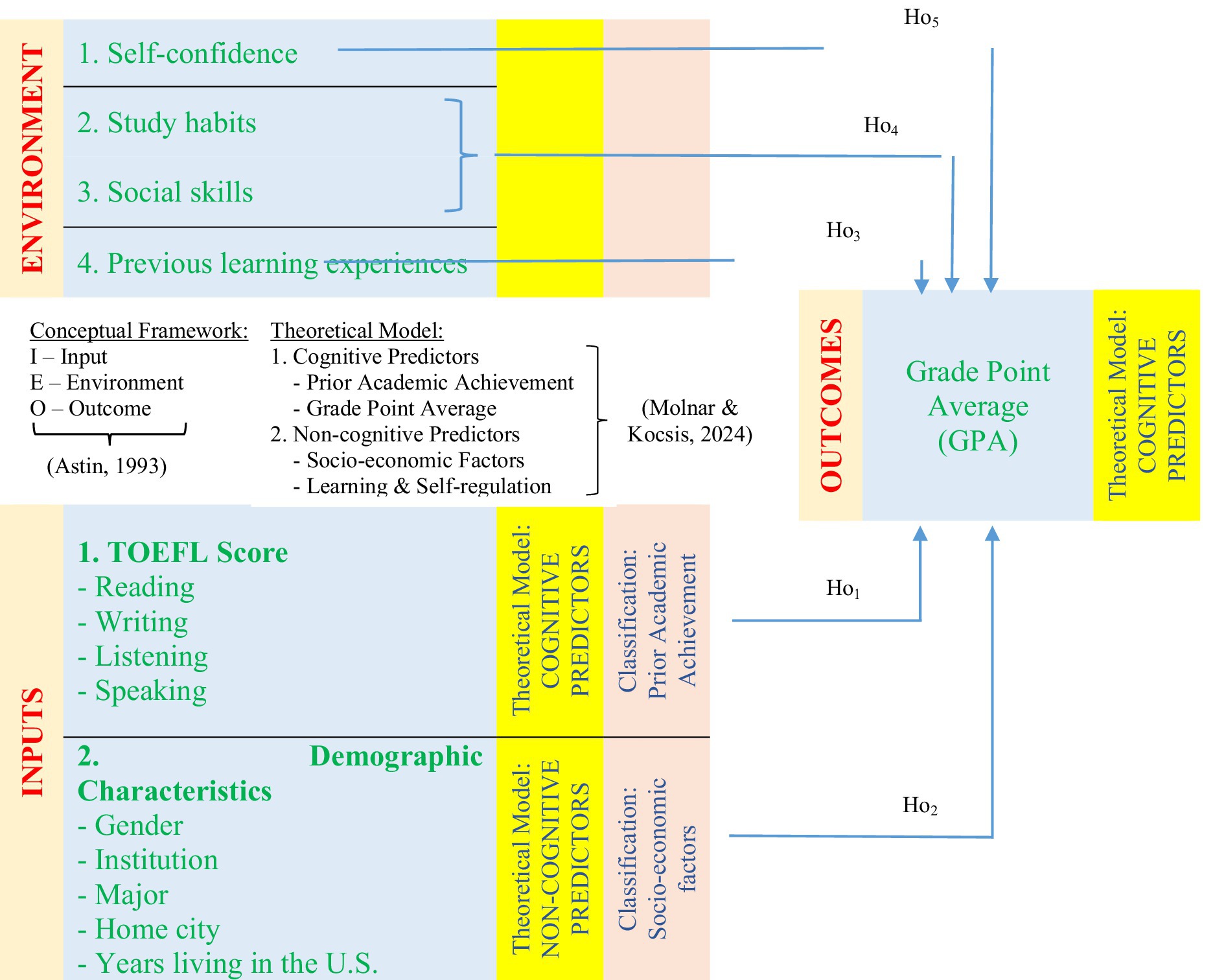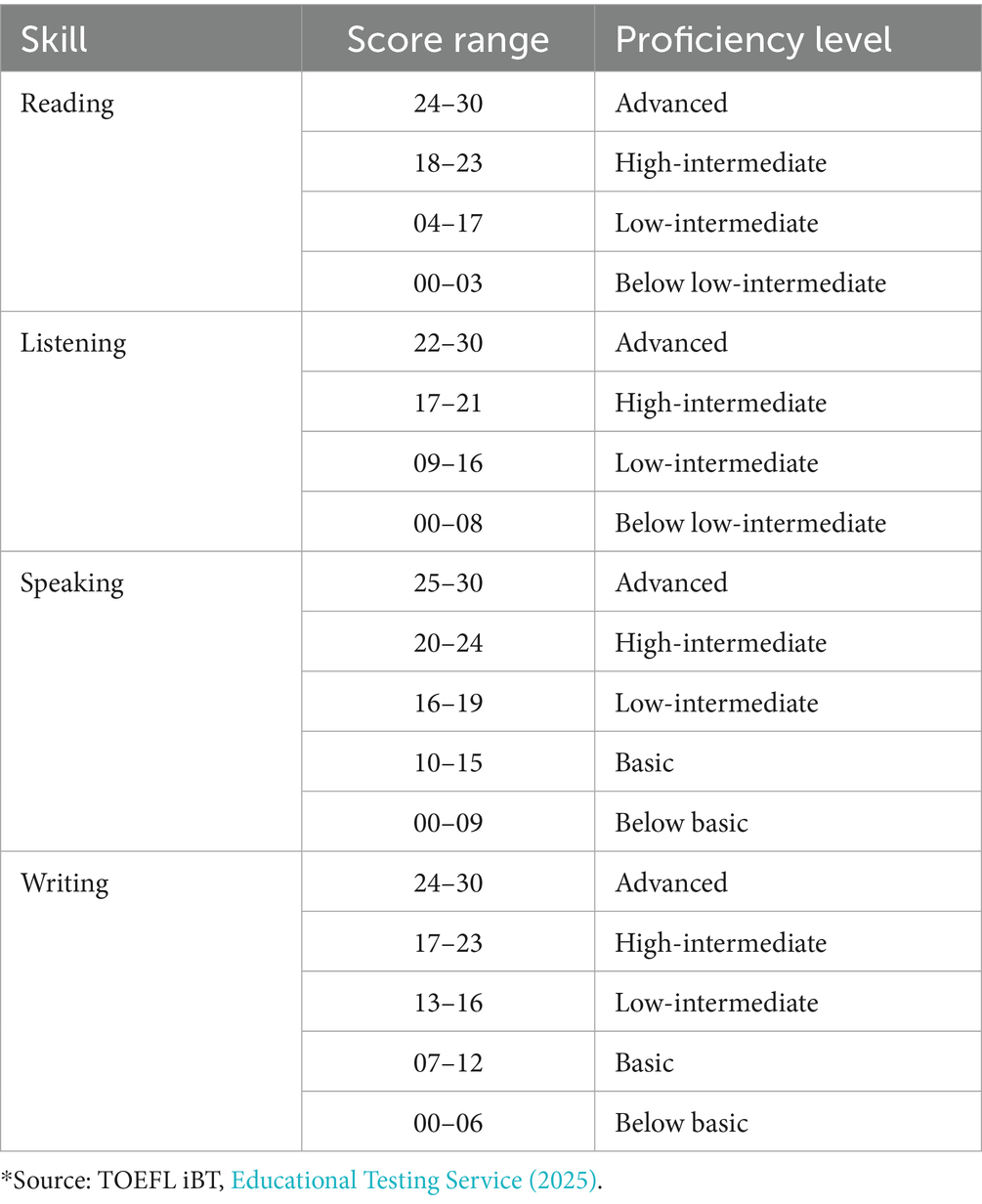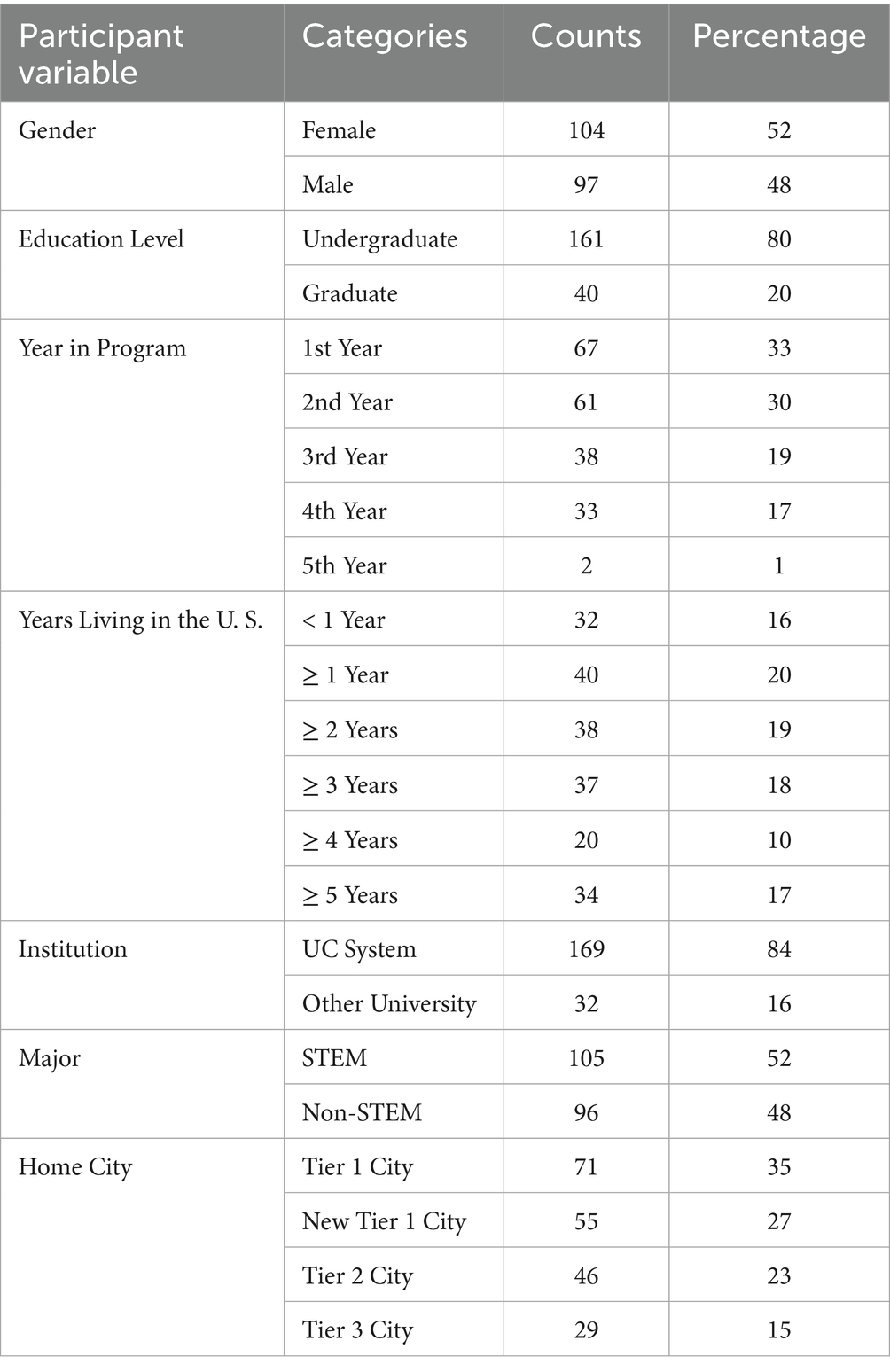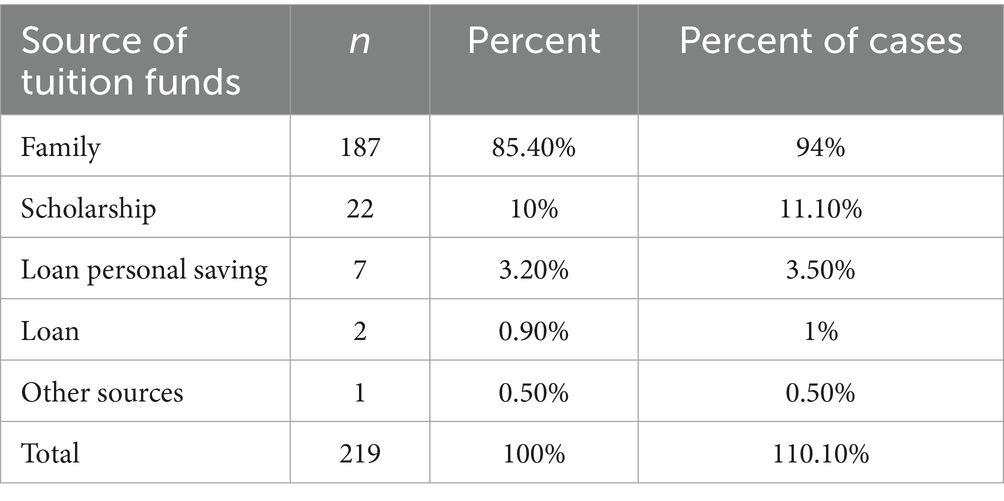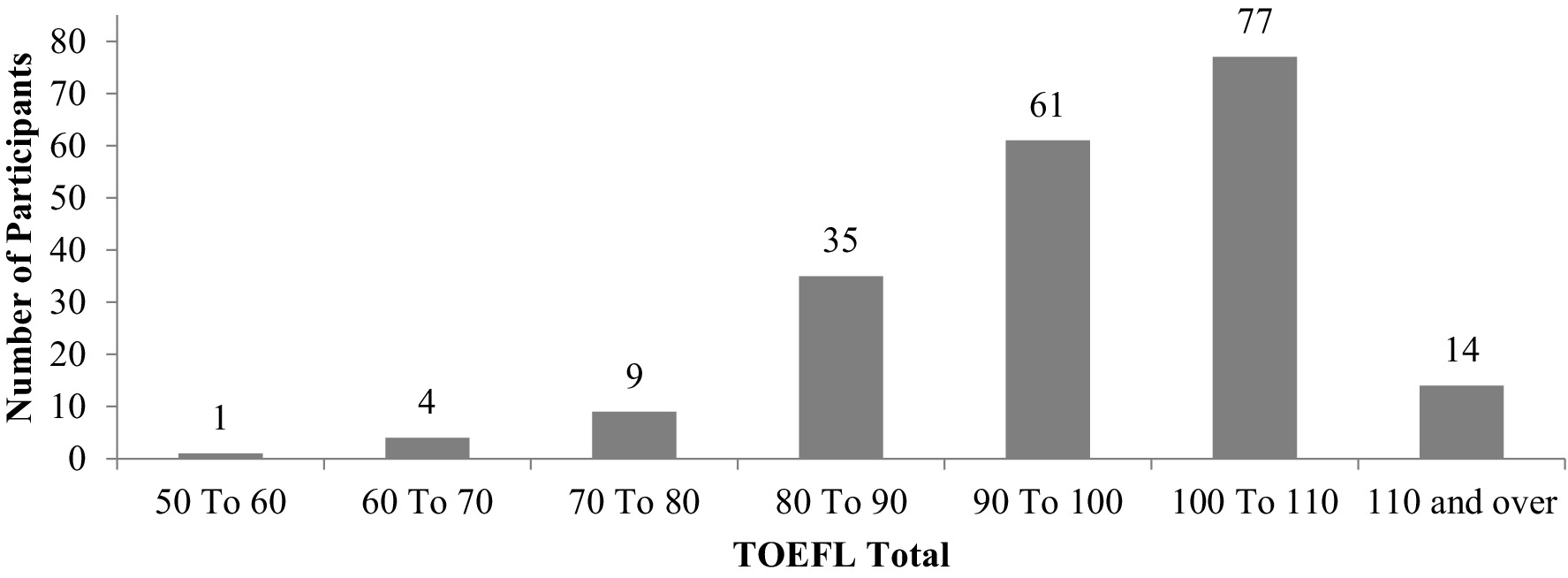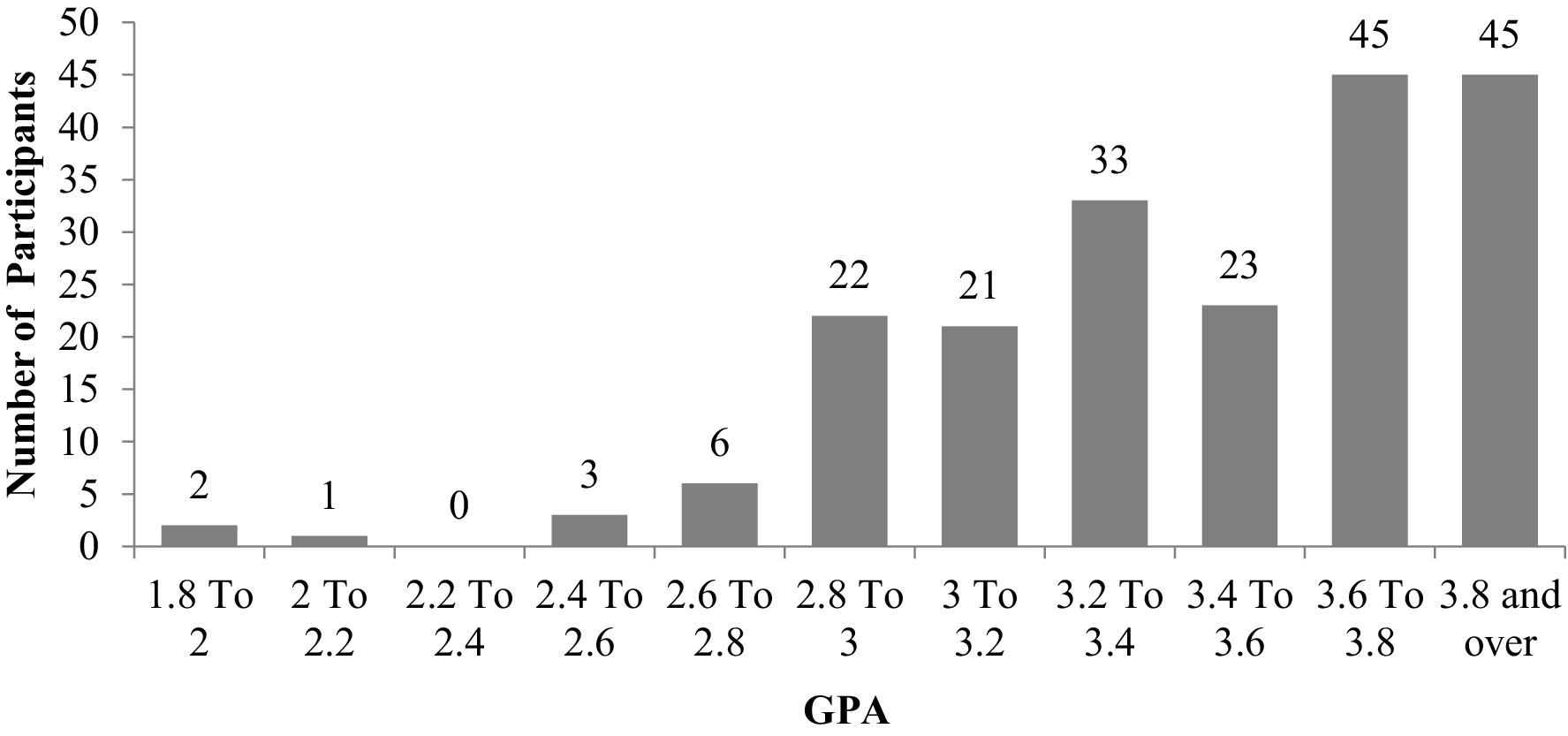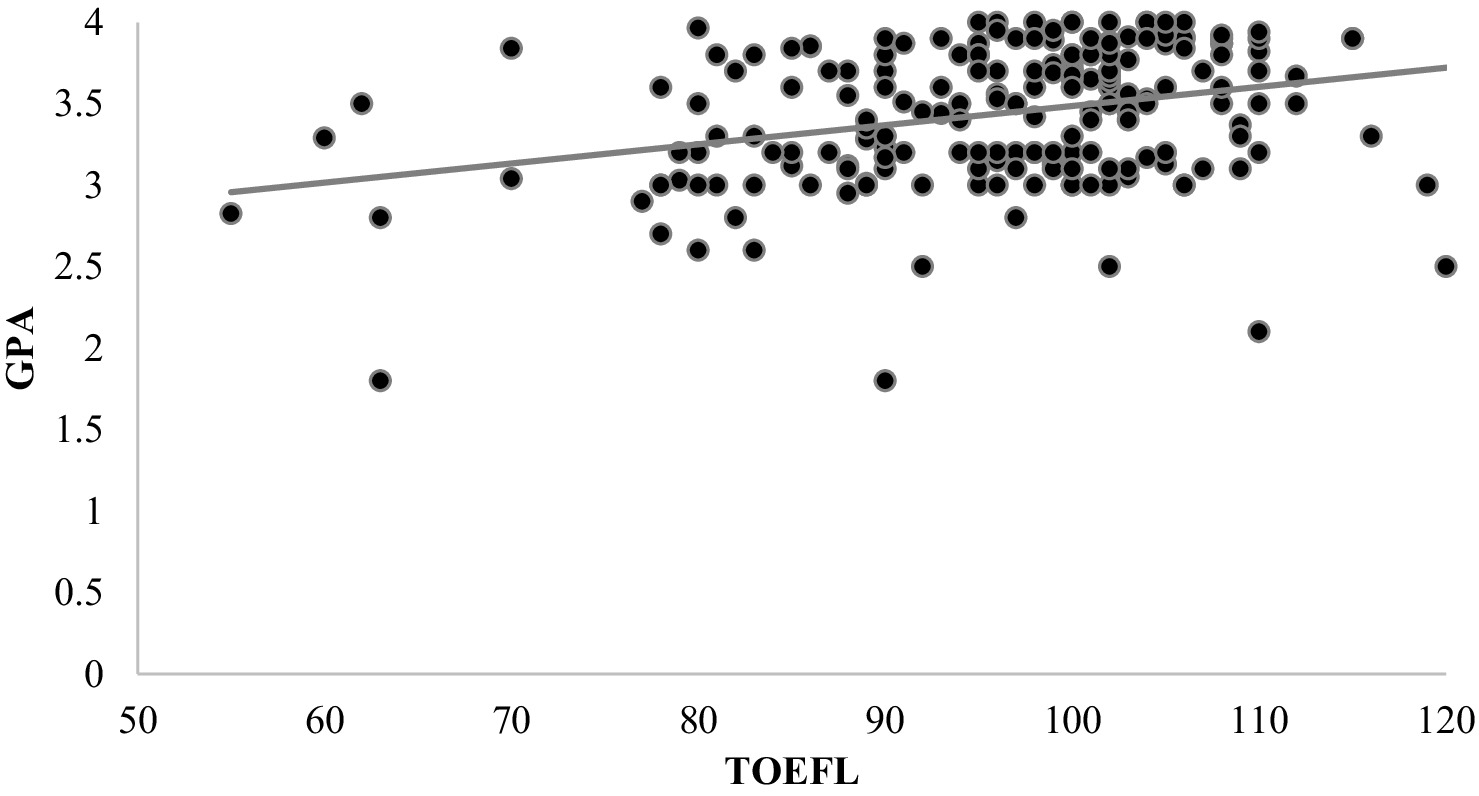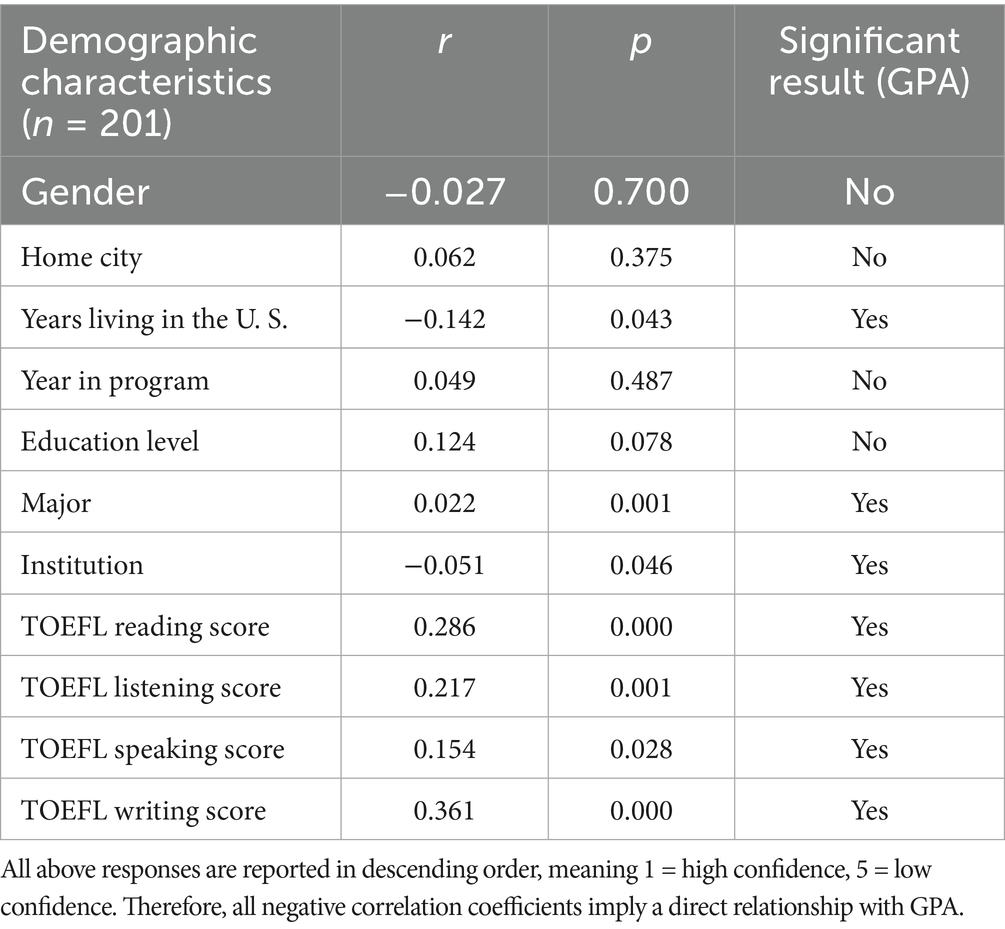- 1School of Education, Guangzhou University, Guangzhou, China
- 2School of Arts and Sciences, Fresno Pacific University, Fresno, CA, United States
This study aims at examining if TOEFL score, demographic characteristics and environmental factors predict the academic success (through GPA) of selected Chinese international students. Using the cognitive predictor model of Molnár and Kocsis as theoretical framework and Astin’s Input-Environment-Outcomes (I-E-O) model as conceptual paradigm, the roles of other input variables (demographic characteristics) and environmental factors (self-confidence, study habits, social skills, previous learning experiences) may as well impact the Chinese international students’ GPA, independently from TOEFL. A total of 201 survey participants were recruited through snowball sampling. Results revealed that majority of the participants gained a TOEFL score of 90 and above with majority earning a GPA of 3.0 and above. This indicated a good academic performance among the participants. Pearson correlation analysis found a moderate positive correlation between TOEFL score and GPA (r = 0.30, p < 0.001) while each of the subsections of TOEFL demonstrated statistically significant positive correlations with GPA: reading (r = 0.287, p < 0.001), listening (r = 0.217, p = 0.002), speaking (r = 0.155, p = 0.028), and writing (r = 0.361, p < 0.001). Years living in the US, Major and Institution were found to predict the participants’ GPA while two indicators of self-confidence (confidence in finishing the program and confidence in earning 3.0 GPA) also predicted their GPA. Likewise, one indicator of study habits (habits are adequate to maintain good grades) is also a predictor of GPA. A Hierarchical Linear Modeling (HLM) analysis revealed that Input variables (Years Living in the US, Institution, Major) explained 7.7% of the variance in students’ GPA. Environmental variables (Self-Confidence, Study Habit) explained an additional 11.5% when controlling Input factors. Thus, a total of 19% of the variation in GPA was explained by Input and Environment factors alone. HLM analysis revealed that the TOEFL score was the strongest factor predicting GPA but only explains 6.9% of the total variation.
Introduction
The desire to earn a degree in another country is innate in a number of young individuals as they believe that acquiring an international education seems to make them more marketable in the job market. This is even more true to some if the degree is acquired from schools in the Western countries, such as the United States (US). According to Khan (2023), there are three main reasons why international students choose US schools: (1) a beacon of academic excellence; (2) career opportunities are plentiful; and (3) students can sample different subjects before choosing their major. While among the seven reasons listed by Zalek (2023), the prestige of studying in US universities was also a distinct reason for many international students as US universities still carry a quality reputation across the board. This includes access to research programs, learning experiences and extracurricular opportunities.
However, the dream of landing a Western education does not come in handy as a number of requirements shall be met prior to acceptance. Integral to this acceptance is the Test of English as a Foreign Language (TOEFL). The TOEFL internet-based test (iBT) is the world’s most widely respected English language assessment and used for admissions purposes in more than 150 countries, including Australia, Canada, New Zealand, the United Kingdom, and the United States (Norris, 2021). In the US, schools vary in terms of the minimum TOEFL iBT requirement to be accepted. Mahdi (2024) articulated that the TOEFL iBT score requirements of US universities range from 79 to 110, with a minimum score of 100 for undergraduate programs, 80 for graduate programs, and 109 for MBA. More so, a TOEFL iBT score is also instrumental in obtaining a student visa. To secure a student visa in the US, meeting the TOEFL score requirements is crucial. While many universities in the US accept scores within the range of 80 to 100, top institutions like MIT, Harvard, and Stanford typically expect scores above 100 (Tripathi, 2025).
Besides having an acceptable TOEFL score, achieving academic success as a student in US universities is also not easy as a number of considerations shall be taken into account. In research parlance, these considerations are simply called “correlates.” Simple as may seem, but correlates matter too as they define how a student would fare and, at the most, achieve academic success. This led the proponent to identify two distinct correlates: (1) students’ demographic characteristics; and (2) environmental factors. With consideration on the ethnicity of the study’s respondents (Chinese international students), demographic characteristic was given due weight to be a correlate considering that several demographic variables can affect their academic success. For instance, in the study of Sakız et al. (2021), socioeconomic status (SES) and campus psychosocial atmosphere, among others, were positively associated with academic achievement. More so, in a systematic review of correlates and antecedents of academic achievement done by Vandana and Sarif (2022), results of thematic analysis revealed that demographic profile, among others, is a correlate of academic achievement. Paramount to the demographics is the respondents’ language being non-native English speakers. Attending a full-English speaking class can be overwhelming for foreign students as they need to decipher and properly decode the words and sentences spoken by their English-native teachers and classmates. In Massachusetts Institute of Technology (MIT), international students who arrive with higher skills in English today than previously, many students – even those who have graduated from English-instruction undergraduate institutions – still have significant gaps in their linguistic skills and cultural knowledge about communication that impact their ability to participate fully and succeed at MIT and beyond. Other demographic variables, such as gender, institution, and years living in the US, were also included as measures.
On the other hand, environmental factors are identified in this study as another correlate of academic success. Borrowed from one of the components of Astin’s (1993) Input-Environment-Outcome model, environment refers to the student’s actual experiences during the educational program. This is represented in the study by the following variables: students’ self-confidence, study habits, social skills and previous learning experiences. According to Joesten (2024), one of the most compelling truths is that confidence can significantly influence a student’s academic performance. It is a dynamic force that extends beyond mere self-belief – a catalyst for engagement, resilience, and achievement. On the other hand, study habits play a vital role in academic success, directly affecting how well students perform on tests (Chen, 2025) while research indicates that social skills are related to behaviors associated with academic success, such as problem-solving, motivation, and strong peer relationships. While the involved variables indicated a favorable effect toward academic achievement, this study may contribute to the above justification or otherwise.
While a plethora of studies using TOEFL as a correlate or predictor of academic success, and employed several types of cohorts, the decision of the proponent to still conduct the same study was prompted by the endeavor to contribute to the continuous research efforts conducted by the Educational Testing Service (ETS). According to John Norris, Senior Research Director under the Research and Development Division of ETS, it is only through a rigorous program of research that a testing company can substantiate claims about what test takers [of TOEFL] know or can do based on their test scores, as well as provide support for the intended uses of assessments and minimize potential negative consequences of score use. Beyond demonstrating this critical evidence of test quality, research is also important for enabling innovations in test design and addressing the needs of test takers and test score users (Norris, 2021). Referring to the objective, the proponent believes that the result of this study can contribute to the body of present data and be as useful as with the other data generated by ETS.
Theoretical framework
Anchored from the cognitive predictor model of Molnár and Kocsis (2023), the study is premised in identifying the correlates of academic achievement based on the classifications articulated in the model: the cognitive predictors; and non-cognitive predictors. For cognitive, the most commonly studied predictors are (1) grade point average (GPA) and credits earned (e.g., Li and Wong, 2019; Naaman, 2021; Van Herpen et al., 2020; as cited in Molnár and Kocsis, 2023); (2) prior academic achievement (PAA) measured by grades and standardized tests (Richardson et al., 2012; Westrick et al., 2021; as cited in Molnár and Kocsis, 2023), such as school-leaving or college admission exam results, which mostly assess aptitude in areas such as mathematics, reading and writing; and, (3) cognitive abilities, including measures of intelligence, reasoning, critical thinking and problem-solving, (e.g., Molnár et al., 2021; Pastén, 2021; York et al., 2015; Shavelson et al., 2015; as cited in Molnár and Kocsis, 2023).
In terms of non-cognitive predictors, the most commonly monitored predictors are (1) socio-economic factors (SES), which explain 9–23% of the variance of academic success (Rodríguez-Musso et al., 2020; Rodríguez-Hernández et al., 2021; as cited in Molnár and Kocsis, 2023); (2) learning and self-regulation strategies (Alhadabi and Karpinski, 2020; Musso et al., 2020; Ribeiro et al., 2019; as cited in Molnár and Kocsis, 2023), which are also mediating factors for GPA and credits earned and explain 16–26% of the variance of academic success (Aydin, 2017; Eckerlein et al., 2018; as cited in Molnár and Kocsis, 2023); and, (3) motivational factors, such as goal orientation and self-efficacy (Alban and Mauricio, 2019; Behr et al., 2020; Bowles and Brindle, 2017; Ndoye et al., 2020; Rump et al., 2017; Vanthournout et al., 2012; as cited in Molnár and Kocsis, 2023), which explain 9–20% of the variance of academic success.
Aligning with the above model, this study outlined a number of variables (as presented in Figure 1) which served as predictors of academic success among Chinese international students. For cognitive abilities (under cognitive predictors), the TOEFL score served as a measure for this variable (Molnár and Kocsis, 2023). This is specifically represented by the scores in reading, writing, listening and speaking. For the socio-economic factors (under the non-cognitive predictors), the demographic characteristics of the respondents accounted for this variable. The measures are gender, institution, major, home city, years living in the U. S. among others (Molnár and Kocsis, 2023). Both TOEFL score and socio-economic factors served as inputs of the study. On the other hand, the study also outlined major variables defined as learning and self-regulation strategies (under the non-cognitive predictors). Serving as environmental factors of the study, the measures are self-confidence, study habits and social skills.
Conceptual paradigm
Yardly (2025) articulated that a conceptual framework organizes the key concepts and variables of a study. It shows how these concepts are related and how they will be examined in the research. It is often informed by theories but is tailored to the specific context of the study. On the other hand, a theoretical framework identifies the specific theories to be used as guide in the analysis. It positions the study within the broader academic literature and provides a basis for interpreting the findings. Therefore, pondering on the above articulations, the proponent deemed it necessary to present the variables in a model where concepts and theories converge. This is to present the function of each variable and illustrate their interrelationships within the paradigm.
Firstly, to illustrate the concepts of the study, Astin’s (1993) Input-Environment-Outcomes (I-E-O) model was employed. The premise of this model is that educational assessments are not accurate without the information on student inputs (I), the educational environment (E), and student outcomes (O). Inputs are the demographic characteristics that a student brings with them from the country of origin when starting college. Environment relates to the cultural fit between a student’s personal characteristics and college’s culture. These experiences include academic and non-academic aspects of college life. Outcomes refer to the growth in a student’s academic success after being exposed to the environment (Swing, 2001). The specific variables identified in each of the I-E-O component defines the phenomena of the study. As such, these phenomena are now seen in a theoretical lens under the cognitive and non-cognitive models of Molnár and Kocsis (2023). Below is an illustration of the convergence between the concepts and theoretical underpinnings of the study:
Applying the tenets of the I-E-O model (Astin, 1993), the study tailor-fitted the identified correlates of academic achievement (as represented by the Grade Point Average; and served as the outcome) in each of the concepts: inputs and environment. The TOEFL score (represented by the cumulative scores of reading, writing, listening and speaking) and the demographic characteristics (as to gender, institution, major, home city and years living in the US) were conceptualized as input variables. On the other hand, environmental factors are represented by self-confidence, study habits, social skills and previous learning experiences. Both environmental variables and input variables are types of independent variables, antecedent variables, or exogenous variables while inputs could also be called control variables or pretests (Astin, 1993). As such, both input and environmental factors were positioned to predict the academic achievement of the respondents.
Research questions
There are four major questions that this research addresses:
1. What are the demographic characteristics of the Chinese international students?
2. What is the achievement of the Chinese international students with respect to the Test of English as a Foreign Language (TOEFL) score and grade point average (GPA)?
3. What is the relationship between the Chinese international students’ TOEFL scores and their academic success as defined by their GPA? Does TOEFL score predict the GPA of Chinese international students?
4. Are demographic characteristics and environmental factors significant predictors of Chinese international students’ GPA?
Hypotheses
As the study focuses on the interplay between the independent variables and dependent variable, its aim is to establish the predictability of the latter variable. Hence, by properly positioning them in the conceptual paradigm (Figure 1), the proponent aims to draw tacit theories by establishing predictive partnerships. In turn, these tacit theories become the working hypotheses of the study – the assumptions and conceptualizations that are bound to be proven through hypotheses testing.
With the above articulation, five (5) null hypotheses were tested by the study at 0.05 level of significance:
Ho1 No significant relationship exists between scores in Test of English as a Second Language (TOEFL) and grade point average (GPA).
Ho2 Demographic characteristics do not predict grade point average (GPA).
Ho3 Previous learning experiences do not predict grade point average (GPA).
Ho4 Study habits and social skills do not predict grade point average (GPA).
Ho5 Self-confidence does not predict grade point average (GPA).
The rationale behind the formation of the above hypotheses lies on the premise that the involved variables are instrumental in yielding the necessary results of the study specifically determining whether the input variables (TEOFL and demographic characteristics) and environmental variables (study habits, social skills, self-confidence, and previous learning experiences) predict academic success (GPA). In the plethora of conducted studies relative to these variables, differing theories came up, hence, two-pronged in nature: some have significantly predicted academic success while some came out otherwise. Thus, the intention of this study is to test the relationship of each paired variable and see if the identified independent variables (input and environmental factors) predict the dependent variable (GPA).
Materials and methods
Research design
This quantitative study aims to describe the demographic characteristics, self-confidence, study habits, social skills, and previous learning experiences of Chinese international students studying in the US. It also determined their achievements in terms of TOEFL score as well as academic achievements in terms of GPA. Descriptive-correlation was specifically used to explore the relationship between the independent variables (TOEFL score, demographic characteristics and environmental factors) and dependent variable (GPA).
Participants
Recruited using snowball sampling, a total of 205 participants completed the quantitative survey. Data review and cleaning yielded 4 participants to be removed due to invalid answers. Thus, with a participation rate of 98%, a total of 201 Chinese international students, with 104 females and 97 males, were included in the study. All the participants were from China but living and studying in the US. Their native language is Chinese. They were drawn from public and private four-year universities in California, United States. Only international students who were officially accepted by undergraduate and graduate programs were considered. Exchange international students, visiting international students, or international students who study credential programs and English programs at extension centers were not considered. A self-created survey instrument developed from previous studies on international students was administered to the participants. It was initially piloted with a voluntary subsample of participants similar to those in the study, and their responses were used to enhance the validity and internal reliability of the instrument.
Instrumentation, measures and data collection
The survey, consisting of short-answer and Likert-style questions, had a total of 31 indicator questions. The first 16 indicators, which consist of demographic questions, are aimed at collecting information about possible extraneous variables representing the respondents’ background that may be relevant to their academic achievement. It also includes questions about their TOEFL score, GPA, and socioeconomic factors. The measure used for academic achievement is the current GPA of the students while the measure used for the TOEFL is the scores in the 4 subsections. To properly interpret the achievement in each of the subsections, below is a matrix of proficiency levels (see Table 1).
The remaining 15 indicators, which consist of five-point Likert-style questions, were used to measure alternative factors that could be associated with international students’ academic success. These 15 questions focused on the students’ enviroment factors (i.e., self-confidence, study habits). This data was used to analyze the pattern of association between students’ characteristics and how these factors associate with GPA independently from TOEFL scores through the use of linear regression. The Likert scale consists of five points (i.e., 1 = strongly agree, 2 = agree, 3 = neutral, 4 = disagree, and 5 = strongly disagree). The scale is negative trending (high to low). Therefore, all negative correlation coefficients mean a direct positive relationship.
The researcher used SurveyMonkey, an online survey platform, to disseminate the survey form. This preserved the anonymity of the participants. During the data collection proper, participants received online invitations and an electronic version of the informed consent form. And, at the beginning of the survey, participants were prompted to click a box stating that they were aware that both the confidentiality of data and their anonymity would be preserved.
Results and discussion
RQ1 Demographic characteristics of the Chinese international students
A total of twelve (12) four-year universities were included in this study (see Table 2). Eighty-four percent (84%) of the participants were students from the University of California systems (n = 169) while 16 % (16%) were from other universities (n = 32). More than half of the participants were in their freshmen and sophomore years (63%). Based on the reported education levels, 80 % (80%) of the participants were undergraduate students (n = 161) while 20 % (20%) were on master and PhD levels (n = 40). Both undergraduate and graduate students attend the same institutions. In terms of residency, 55 % (55%) of the participants had been living in the U. S. for less than 3 years (n = 110) while 45 % (45%) had been in the U. S. for 3 years or more (n = 91). They were also enrolled in various majors. A total of fifty-two (52%) were STEM majors (Science, technology, engineering, and mathematics) (n = 105) whereas 48 % (48%) were in non-STEM majors (n = 96). Engineering-related majors (computer engineering, electrical engineering, environmental engineering, etc.) were the most popular majors in STEM fields at 27% (n = 54) intake. In non-STEM fields, business-related majors (Finance, Management, Marketing, etc.) were the most popular at 28% (n = 57). Only 3% of the participants have majors in humanities, such as fine arts and English (n = 6).
Tier city is the tool to identify city development level in China based on cities’ GDP, population, median income, transportation, and education. Research reports financial and educational gaps between Tier 1 cities and non-Tier 1 cities. There are four cities that are Tier 1 cities: Beijing, Shanghai, Guangzhou, and Shenzhen. Non-Tier 1 cities are Xi’an, Hangzhou, Wuhan and Chongqing (Yicai Global, 2017). Among the 201 participants, 35% were from Tier 1 cities (n = 71) and 65% were from non-Tier 1 cities (n = 130) in China. Non-Tier 1 cities include New Tier 1 cities, Tier 2 cities, Tier 3 cities, Tier 4 cities, and others. There were no participants from Tier 4 and 5 cities.
As seen in Table 3, 85.40% of the participants were paying their tuition using mainly family support (n = 187) whereas only 10% of the participants were paying their tuition using scholarship funds (n = 22).
RQ2 Achievement of the Chinese international students with respect to the test of English as a foreign language (TOEFL) score and grade point average (GPA)
All participants in this study took the TOEFL iBT test. Therefore, the results are referred to as the TOEFL iBT test scores. Among the 201 participants, majority (n = 77) had TOEFL scores ranging from 100 to 110 (see Figure 2) while 61 had score ranging from 90 to 100. Of the students who got accepted in US universities, 138, or 69%, scored 90 or above in the TOEFL, which is higher than the average score for China as a country which is 79 (Educational Testing Service, 2017). In the TOEFL subsection scores (Table 3), standard deviations and means across the subscales.
Each section in the test has a score range of 0–30. These are added together for a total score of 0–120 (Educational Testing Service, 2025). The TOEFL subsection scores and total score (see Table 4) showed favorable results as the numbers indicated a good performance among the 201 participants. Though the score in each dimension is marginally near when compared across all dimensions, the reading dimension gained the highest mean score of 25.24 and interpreted as “Advanced” level while the listening skill gained the second highest with 24.65 and interpreted as “Advanced” level. Likewise, the participants were also in “Advanced” level in terms of writing dimension having gained a mean score of 24.36. Last on the dimensions, but definitely not low, is the speaking skill with an indicative mean score of 23.19 and interpreted as “High Intermediate.” The total mean score of 95.91 indicates a good achievement among the participants of this study.
The mean GPA was 3.43, the median was 3.5, and the standard deviation was 0.41. Among the 201 participants, 167, or 83% of the participants, had a GPA above 3.0 while 44% (n = 90) had a GPA above 3.6 (see Figure 3). By analysis, these data indicate good academic performance among the participants.
RQ3 Relationship between the Chinese international students’ TOEFL scores and their academic success as defined by their GPA
The computed Pearson correlation coefficient showed a moderate, positive correlation between the TOEFL scores and GPA, with r (201) = 0.30, p < 0.001. The scatterplot in Figure 4 summarizes the results. The higher the TOEFL scores, the higher the GPA was. As this distribution indicates, it clusters on the middle. Therefore, TOEFL predicts GPA.
The results in Table 5 demonstrate statistically significant positive correlations between GPA and all TOEFL subdomains – reading (r = 0.287, p < 0.001), listening (r = 0.217, p = 0.002), speaking (r = 0.155, p = 0.028), and writing (r = 0.361, p < 0.001) – as well as with the overall TOEFL score (r = 0.312, p < 0.001), indicating that higher English proficiency is associated with better academic performance.
RQ4 Demographic characteristics and environmental factors as significant predictors of Chinese international students’ GPA
A Pearson correlation analysis was used to examine which demographic variables (previously identified from the theory) relate and show a positive association with GPA. Data on these factors were transformed from non-interval variables into dummy variables to run the regression analysis. Specifically, Home City was coded to Tier 1 city = 1 vs. non-Tier 1 = 0 dummy variables; Institution was coded to UC = 1 vs. non-UC = 0 dummy variables; Major was coded to STEM = 1 vs. non-STEM = 0 dummy variables. Pearson correlation (n = 201) results showed that Years Living in the US, Institution, and Major were significantly and positively correlated to GPA (see Table 4). Therefore, these input variables were used in the hierarchical regression model as predictors of GPA (Table 6).
Surprisingly, previous learning experiences, represented by Question 23 (Classes taught in the US are similar to those taught in my home country) and Question 24 (I am able to adapt to the teaching style of the United States), have no significant correlation with GPA (see Table 7).
On the other hand, there were 13 Likert-style questions related to other environmental factors. Previous researches revealed three factors that relate to GPA: self-confidence, study habits, and social network. Thus, for self-confidence, 9 indicator questions were developed for this study (see Table 8). Out of the 9 questions, 2 indicated a positive correlation with GPA: Question 17 (I feel confident about finishing my program), and Question 18 [I feel confident about earning a 3.0 GPA (or higher) at the time when I graduate]. The Pearson correlation analysis showed a positive correlation between 2 self-confidence indicators and GPA, r (199) = −1.80, −0.353, p < 0.05. These two questions were about confidence in their performance in college; hence, they will be used here as a proxy for self-confidence. Surprisingly, questions about confidence in their academic skills were not related to their GPA; thus, they were not used in the regression model.
The remaining 4 Likert-style questions under environmental factors cover the Study Habits and Social Network. Pearson correlation coefficient analysis (n = 201) reported that there was a correlation between Question 25 (My study habits are adequate to maintain good grades) and the GPA (see Table 9). This question was then used as a proxy for study habits. The other questions explored the impact of studying with English speakers versus Chinese speakers, but they were not associated with GPA.
A hierarchical regression analysis using three models was done. The first model investigated the impact of input factors (Years Living in the US, Institution, Major). The second model looked at environmental factors, such as study habits and self-confidence. The third model included the effect of TOEFL, another input factor, when controlling for input (demographic) and environmental factors (Table 10).
The demographic (input) variables replicated previous findings as they all remained positively related to GPA, explaining 7.7% of the variance. The environmental factors in Model 2 were also associated positively with GPA after controlling for input (demographic) variables. The total variance explained by these two models together was 19.2%, F (5, 195) = 9.24, p < 0.001. The two environmental factors explained an additional 11.5% of the variance in GPA in addition to the 7.7% explained by the first model. After the first two models explained 19.2% of the variance in GPA, the total TOEFL score in Model 3 explained only 6.9%. The total variance explained by the model was 23.8%, F (6, 194) = 11.41, p < 0.001. In the final model, all six control measures were statistically significant, with total TOEFL recording the highest beta value (β = 0.278, p < 0.001). Self-confidence recorded the second highest beta value (β = −0.245, p < 0.001). Major recorded the third highest beta value (β = 0.170, p < 0.01). Years living in the US recorded the fourth beta value (β = −0.166, p < 0.05). Study Habit recorded the fifth beta value (β = −0.151, p < 0.05). Institution had the lowest beta value (β = −0.145, p < 0.05).
The findings showed that TOEFL only has a moderate correlation with GPA. Other factors such as self-confidence, study habits, and years living in the US are also related to Chinese international students’ academic success. Focusing exclusively on TOEFL scores has negative implications related to diversity and social equity; most students who score high in TOEFL come from Tier-1 and Tier-2 cities and tend to be of higher socioeconomic status. The city-tier system was associated with TOEFL scores though not to GPA. These findings imply that access to quality education in China is related to higher TOEFL scores, and, thus, a higher chance of admission to US universities. On the other hand, students from lower tier cities (who had lower TOEFL scores on average) did just as well as those from higher tier cities, implying that once accepted, the home city tier does not influence GPA. Hierarchical Linear Modeling further revealed that demographic factors (major, institution, years living in the US) explained 7.7% of variance in students’ GPA. When controlling demographic variables, environmental variables (self-confidence, study habits) explained an additional 11.5%. When controlling for all other factors, TOEFL only explained 6.9% of the variation. These findings, as well as the association between Tier city and TOEFL, indicate that the relationship between TOEFL and GPA is also influenced by input and environment factors. It also seems that admission to US universities shows a bottleneck effect, where students who do not have access to quality education, like living in a Tier-3 or Tier-4 city, are less likely to have the opportunity to attend US universities.
The study aimed to test specific hypotheses about the relationships between variables in the study by adding predictors in a theoretically justified order. With the literatures reviewed for this study, it appeared that varied results were yielded. Thus, these theories helped the researcher to identify which variables are relevant to include in the model. This ensured that the analysis is grounded in existing knowledge. Empirically, the cognitive predictor model of Molnár and Kocsis (2023) is the main anchor of the study. It was premised in identifying the correlates of academic achievement based on two model classifications: the cognitive predictors; and non-cognitive predictors. As seen in the conceptual paradigm section (Figure 1), an illustration of the independent variables (inputs and environment) and dependent variable were presented with corresponding sub-variables for TOEFL score (reading, writing, listening, speaking), demographic characteristics (gender, institution, major, home city, years living in the US) and environment (self-confidence, study habits, social skills, previous learning experiences). While a number of independent variables in the study have predicted academic success, such as the one with Cho and Bridgeman (2012), indicating that higher TOEFL iBT scores tended to earn higher GPAs, also with Ruegg et al. (2024) which indicated that ESL students’ language proficiency test (LPT) had a significant effect on their undergraduate academic achievement, and from Jingfu (2024) who revealed that students who maintain higher levels of self-confidence consistently achieve better academic outcomes across various subjects and assessment types, a combination of these variables to form a model have yet to be done in as far as the rigors of literature review by the proponent is concerned. Hence, grounding the generated models from these existing theories, the study aims to contribute new bodies of knowledge especially in underscoring the importance of considering multiple predictors to fully understand the factors influencing the outcome variable.
Limitations
There are a few limitations to this study. First, the sample of international students was drawn from California and a few specific universities using convenience and snowball sampling; therefore, generalizations to other states might be limited. Second, each academic institution or department may have different grading standards; therefore, caution needs to be exercised in comparing GPAs of international students across different universities. Third, there are other ways to measure success, such as career placement after graduation, which was not taken into consideration in this study. The researcher chose to conduct this research in California as the state has a large international student body. Although the sample of participants for this study was drawn from a limited number of universities in California, the target universities have diverse international student bodies, which allowed for diverse perspectives to be collected to answer the research questions of this study better.
Conclusion
In conclusion, this study offers critical insights into the relationship between TOEFL scores and academic success among Chinese international students, who constitute a significant proportion of the international student body in the US. By focusing exclusively on this group, the research captures a wide range of experiences and variations within this demographic. The findings provide empirical evidence that can guide admissions officers, student affairs officers, and university administrators in making more informed decisions regarding the evaluation of international students. We earnestly hope that our findings will pave the way for further exploration and deeper understanding in this important area of study.
Data availability statement
The datasets presented in this study can be found in online repositories. The names of the repository/repositories and accession number(s) can be found in the article/supplementary material.
Ethics statement
The studies involving humans were approved by ethics committee: Concordia University Irvine. The studies were conducted in accordance with the local legislation and institutional requirements. The participants provided their written informed consent to participate in this study.
Author contributions
YY: Writing – original draft. BM: Writing – review & editing.
Funding
The author(s) declare that no financial support was received for the research and/or publication of this article.
Conflict of interest
The authors declare that the research was conducted in the absence of any commercial or financial relationships that could be construed as a potential conflict of interest.
Generative AI statement
The authors declare that no Gen AI was used in the creation of this manuscript.
Publisher’s note
All claims expressed in this article are solely those of the authors and do not necessarily represent those of their affiliated organizations, or those of the publisher, the editors and the reviewers. Any product that may be evaluated in this article, or claim that may be made by its manufacturer, is not guaranteed or endorsed by the publisher.
References
Alban, M., and Mauricio, D. (2019). Predicting university dropout trough data mining: a systematic literature. Indian J. Sci. Technol. 12, 1–12. doi: 10.17485/ijst/2019/v12i4/139729
Alhadabi, A., and Karpinski, A. C. (2020). Grit, self-efficacy, achievement orientation goals, and academic performance in university students. Int. J. Adolesc. Youth 25, 519–535. doi: 10.1080/02673843.2019.1679202
Astin, A. W. (1993). Assessment for excellence: The philosophy and practice of assessment and evaluation in higher education. Phoenix, AZ: The Oryx Press.
Aydin, G. (2017). Personal factors predicting college student success. Eurasian J. Educ. Res. 17, 93–112. doi: 10.14689/ejer.2017.69.6
Behr, A., Herve, M. G. M. D., Kamdjou, T., and Theune, K. (2020). Dropping out of university: a literature review. Rev. Educ. 8, 614–652. doi: 10.1002/rev3.3202
Bowles, T. V., and Brindle, K. A. (2017). Identifying facilitating factors and barriers to improving student retention rates in tertiary teaching courses: a systematic review. Higher Educ. Res. Dev. 36, 903–919. doi: 10.1080/07294360.2016.1264927
Chen, Z. (2025). Study habits and their impact on exam results: why good study habits are crucial for academic success. Teach them to study. Available online at: https://www.teachthemtostudy.com/articles/study-habits-impact-exam-results-success.
Cho, Y., and Bridgeman, B. (2012). Relationship of TOEFL iBT® scores to academic performance: some evidence from American universities. Lang. Test. 29, 421–442. doi: 10.1177/0265532211430368
Eckerlein, N., Bäulke, L., and Dresel, M. (2018). Interrelations between motivational regulation, procrastination and college dropout intentions. Unterrichtswissenschaft 46, 461–479. doi: 10.1007/s42010-018-0029-5
Educational Testing Service. (2017). Structure of the TOEFL iBT® test and revised TOEFL paper-delivered test. Available online at: https://www.ets.org/toefl/institutions/about/content/content_structure/.
Educational Testing Service. (2025). Understanding your TOEFL iBT scores. Available online at: https://www.ets.org/toefl/test-takers/ibt/scores/understand-scores.html.
Jingfu, L. (2024). Self-confidence as a predictor of academic and sports performance among college students. Int. J. Novel Res. Educ. Learn. 11, 90–97. doi: 10.5281/zenodo.14557955
Joesten, L. (2024). Building student confidence: a key to academic success. Empowering Student Success. Available online at: https://www.empoweringstudentsuccess.com/post/building-student-confidence-a-key-to-academic-success.
Khan, A. (2023). Why are students choosing to study in the US? Top Universities. Available online at: https://www.topuniversities.com/student-info/studying-abroad-articles/why-are-students-choosing-study-us.
Li, K. C., and Wong, B. T. (2019). Factors related to student persistence in open universities: changes over the years. Int. Rev. Res. Open Distrib. Learn. 20, 132–151. doi: 10.19173/irrodl.v20i4.4103
Mahdi, M. (2024). How high of a TOEFL score is needed to get into us universities? Cambridge DB.com. Available online at: https://cambridgedb.com/how-high-of-a-toefl-score-is-needed-to-get-into-us-universities.html.
Molnár, G., Hódi, A., Molnár, E. D., Nagy, Z., and Csapó, B. (2021). Assessment of first-year university students: facilitating an effective transition into higher education. In: Új kutatások a neveléstudományokban 2020, pp. 11–26.
Molnár, G., and Kocsis, Á. (2023). Cognitive and non-cognitive predictors of academic success in higher education: a large-scale longitudinal study. Stud. High. Educ. 49, 1610–1624. doi: 10.1080/03075079.2023.2271513
Musso, M. F., Hernández, C. F. R., and Cascallar, E. C. (2020). Predicting key educational outcomes in academic trajectories: a machine-learning approach. High. Educ. 80, 875–894. doi: 10.1007/s10734-020-00520-7
Naaman, H. (2021). The academic dropout wheel Analyzing the antecedents of higher education dropout in education studies. Eur. Educ. Res. 4, 133–153. doi: 10.31757/euer.421
Ndoye, A., Clarke, S., and Henderson, C. (2020). Predicting college students’ academic success. J. Stud. Success Retention 6, 36–61.
Norris, J. (2021). Using TOEFL iBT® test scores for selecting international teaching assistants, 10. TOEFL Research Insight. Available online at: https://www.ets.org/pdfs/toefl/toefl-ibt-insight-s1v10.pdf.
Pastén, L. E. (2021). Metacognitive, critical and creative thinking in educative contexts: conceptualization and didactic suggestions. Psicol. Escol. Educ. 25:278. doi: 10.1590/2175-35392021220278
Ribeiro, L., Rosário, P., Núñez, J. C., Gaeta, M., and Fuentes, S. (2019). First-year students background and academic achievement: the mediating role of student engagement. Front. Psychol. 10:2669. doi: 10.3389/fpsyg.2019.02669
Richardson, M., Abraham, C., and Bond, R. (2012). Psychological correlates of university students’ academic performance: a systematic review and meta-analysis. Psychol. Bull. 138, 353–387. doi: 10.1037/a0026838
Rodríguez-Hernández, F., Felipe, C., Musso, M., Kyndt, E., and Cascallar, E. (2021). Artificial neural networks in academic performance prediction: systematic implementation and predictor evaluation. Comput. Educ. 2:100018. doi: 10.1016/j.caeai.2021.100018
Ruegg, R., Hoang, H., and Petersen, N. (2024). The influence of English language proficiency test scores on the academic success of ESL undergraduate students. Educ. Res. Eval. 29, 111–129. doi: 10.1080/13803611.2024.2314533
Rump, M., Esdar, W., and Wild, E. (2017). Individual differences in the effects of academic motivation on higher education students’ intention to drop out. Eur. J. High. Educ. 7, 341–355. doi: 10.1080/21568235.2017.1357481
Sakız, H., Özdaş, F., Göksu, İ., and Ekinci, A. (2021). A longitudinal analysis of academic achievement and its correlates in higher education. SAGE Open 11:85. doi: 10.1177/21582440211003085
Shavelson, R. J., Zlatkin-Troitschanskaia, O., and Kuhn, C. (2015). The international state of research on measurement of competency in higher education. Stud. High. Educ. 40, 393–411. doi: 10.1080/03075079.2015.1004241
Swing, R. L. (2001). Proving and improving: strategies for assessing the first college year. The first-year experience (monograph series no.33). Available online at: https://files.eric.ed.gov/fulltext/ED458855.pdf.
Tripathi, A. (2025). TOEFL iBT® score requirements for USA study visa. TOEFL Test Prep. Available online at: https://toefltestprep.com/blog/toefl-score-for-usa-study-visa.
Van Herpen, S. G. A., Meeuwisse, M., Hofman, A. W. H., and Severiens, S. E. (2020). A head start in higher education: the effect of a transition intervention on interaction, sense of belonging, and academic performance. Stud. High. Educ. 45, 862–877. doi: 10.1080/03075079.2019.1572088
Vandana, V., and Sarif, N. M. (2022). Correlates and antecedents of academic achievement: a systematic review. Int. J. Educ. Sci. 36, 19–29. doi: 10.31901/24566322.2022/36.1-3.1210
Vanthournout, G., Gijbels, D., Coertjens, L., Donche, V., and Van Petegem, P. (2012). Students’ persistence and academic success in a first-year professional bachelor program: the influence of students’ learning strategies and academic motivation. Educ. Res. Int. 12, 1–10. doi: 10.1155/2012/152747
Westrick, P. A., Schmidt, F. L., Le, H., Robbins, S. B., and Radunzel, J. M. R. (2021). The road to retention passes through first year academic performance: a meta-analytic path analysis of academic performance and persistence. Educ. Assess. 26, 35–51. doi: 10.1080/10627197.2020.1848423
Yardly, E. (2025). Navigating research terminology: paradigms, theories, and frameworks explained. Degree Doctor Available online at: https://www.thedegreedoctor.com/blog/paradigms-theories-and-frameworks.
Yicai Global. (2017). Chengdu, Hangzhou, and Wuhan are the top three cities on the list of ‘new tier 1′ cities in 2017. Zhengzhou and Dongguan are new cities on the list. Yicai Global. Available online at https://www.yicai.com/news/5293378.html.
York, T. T., Gibson, C., and Rankin, S. (2015). Defining and measuring academic success. Pract. Assess. Res. Eval. 20:5. doi: 10.7275/hz5x-tx03
Zalek, E. (2023). Top 7 reasons international students should study in the U.S. ISO International Student. Available online at: https://www.isoa.org/blog/top-7-reasons-international-students-should-study-in-the-u.s.
Keywords: TOEFL, demographic characteristics, environmental factors, I-E-O model, cognitive predictor model, Chinese international students’, academic success, GPA
Citation: Yan Y and Meyer B (2025) Beyond TOEFL: multivariate predictors of academic achievement in Chinese international students. Front. Educ. 10:1604057. doi: 10.3389/feduc.2025.1604057
Edited by:
Margaret Funke Omidire, University of Pretoria, South AfricaReviewed by:
Maura Pilotti, Prince Mohammad bin Fahd University, Saudi ArabiaClara Orban, DePaul University, United States
Copyright © 2025 Yan and Meyer. This is an open-access article distributed under the terms of the Creative Commons Attribution License (CC BY). The use, distribution or reproduction in other forums is permitted, provided the original author(s) and the copyright owner(s) are credited and that the original publication in this journal is cited, in accordance with accepted academic practice. No use, distribution or reproduction is permitted which does not comply with these terms.
*Correspondence: Yuyang Yan, eWFuLnl1eWFuZ0Bnemh1LmVkdS5jbg==
 Yuyang Yan
Yuyang Yan Blanca Meyer2
Blanca Meyer2